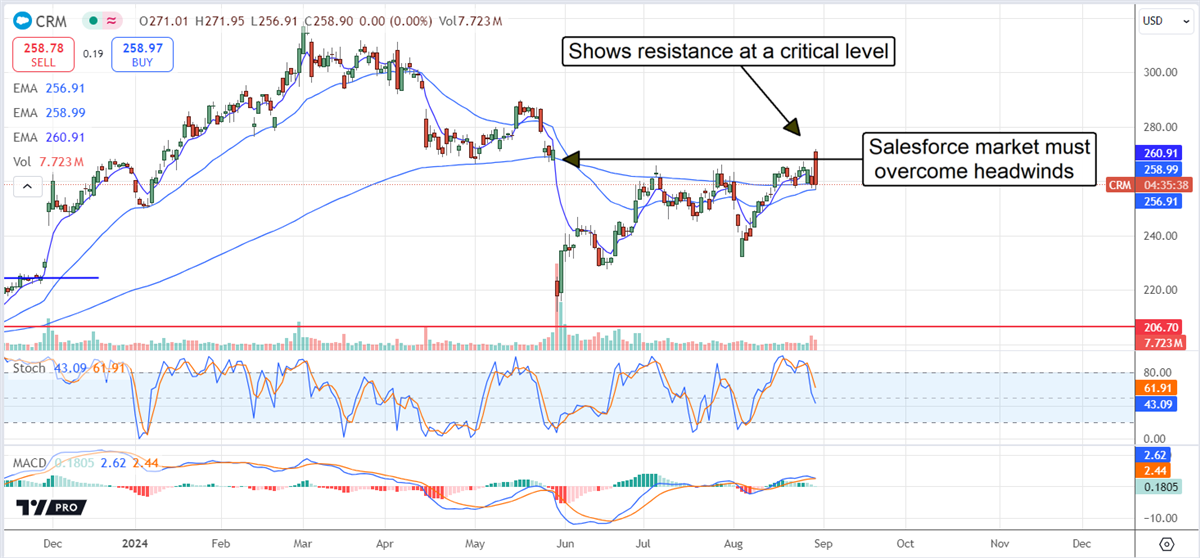Salesforce CRM faces a turbulent terrain as its stock price hits a firm resistance point, raising doubts about scaling new heights imminently. Despite a solid Q2 performance and upgraded guidance, the company finds itself grappling with formidable challenges ahead. The headwinds include decelerating growth, macroeconomic uncertainties, and the treacherous terrain of September trading patterns. Historically, September often unfurls a scenario of intense volatility and probable downward pressures on stocks. Moreover, with the looming FOMC decisions and inflation concerns on the rise, the risks appear substantial.
For investors, the current outlook hints at an impending dip in CRM shares, potentially paving the way for a more enticing entry point as the long-term prospects of the company remain promising. The ongoing global transition towards digitization and intensified focus on customer engagement continue to steer business growth. In an era where digitization serves as the linchpin for maximizing efficiency and profitability, the trajectory for Salesforce appears optimistic, sustaining robust cash flows capable of sustaining dividends, share buybacks, and growth investments.
Evaluating Salesforce’s Growth Trajectory
Following a quarter that exceeded expectations, Salesforce faces constraints on potential gains post-results. Notably, the revenue growth rate of 8.5% has dipped sequentially and year-over-year, with no anticipated uptick in 2024. Additionally, analysts progressively revised their projections lower throughout the quarter, setting a conservative benchmark that dampened the impact of the company’s outperformance. While the results surpassed consensus figures by roughly $0.1 billion, representing a marginal 1% increase, the growth was primarily fueled by a 9% surge in Subscription Services juxtaposed with a decline in Professional services.
The margin dynamics are a silver lining in the otherwise complex report. Witnessing improvements across all levels, Salesforce marked a 190-basis-point enhancement in reported operating margins and a 210-basis-point surge in adjusted operating margins. Both adjusted and GAAP margins hit record levels, fueling a double-digit surge in cash flows, free cash flows, and a substantial 20% leap in adjusted earnings, surpassing consensus by 840 basis points.
While the provided guidance is favorable, it introduces another stumbling block in the current market landscape. Despite elevating Q3 growth projections to 7%, Salesforce’s forecast falls below the consensus stance, instigating skepticism about its full-year performance. The reaffirmed full-year outlook anticipates an 8.4% growth rate, aligning with Marketbeat’s consensus, failing to act as a potent catalyst for upward share price movements.
Focusing on Cash Flow and Capital Returns
Amidst decelerating growth trends, Salesforce investors pivot towards robust capital returns as a beacon of value. The Q2 results have empowered the company to execute substantial buybacks, resulting in a 1.3% average reduction in share count quarterly, with expectations of continued strength throughout the year. Emphasizing this capital allocation strategy, CFO Amy Weaver remarks, “Our capital return program remains a priority, and we now expect to more than fully offset our dilution from FY25 stock-based compensation.”
However, investors confront the looming risk that Artificial Intelligence (AI), Salesforce’s current stronghold, providing businesses with monumental computational capabilities, may inadvertently become its nemesis. While the company excels in rendering Software as a Service (SaaS) solutions critical for business operations, enterprises are rapidly transitioning towards a do-it-yourself approach. Entities like Klarna from Sweden are on the brink of phasing out Salesforce and Workday solutions, opting to consolidate workloads internally into a more streamlined, user-friendly, and scalable framework.
Assessing Salesforce Analysts’ Projections
Despite analysts revising Salesforce’s stock price targets upwards in Q3, the prospects for substantial upside remain constrained. While certain revised targets position the stock at all-time highs, the bulk align with consensus estimates, capping the potential for significant gains above recent peaks. The critical resistance level at approximately $265 signifies a formidable hurdle, hinting at an impending downturn. In case of a breach below the crucial support mark around $260, a downward trajectory towards the robust support base at $240 becomes a plausible scenario.

The article “Pain for Salesforce Today: Gains for Investors Tomorrow?” initially appeared on MarketBeat.
